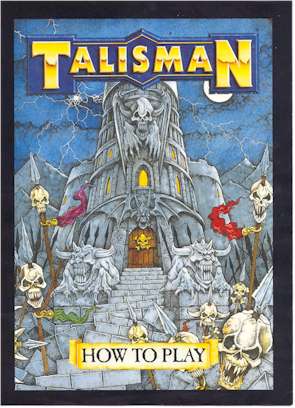

|
THE GAME OF TALISMAN |
Y
ou are an adventurer on a quest to retrieve the fabled Crown of Command from its fearsome guardian, the Dragon King, so you can become ruler of the land. On your journey you will encounter powerful enemies, discover friends and magical objects, and meet strange beings. Finally, when you have gained sufficient power, you can confront the Dragon King in your bid to secure the Crown of Command.|
WINNING THE GAME |
The Talisman fantasy board game can be played by up to six players. The object of the game is to journey to the Wizard's Tower at the centre of the board, defeat the Dragon King and win the game. Players should first spend some time adventuring in the outer and inner regions to build up their abilities until they feel they are powerful enough to enter the Tower. Generally speaking, only characters with a strength or craft of 10 or more should consider entering the Wizard's Tower.
|
COMPONENTS |
Your copy of Talisman should include the following components:
The game board.
11 Character Citadel miniatures.
10 Slottabase stands for the above.
11 Character cards.
129 Adventure cards.
30 Spell cards.
40 Purchase cards.
5 Tower cards.
6 Talisman cards.
6 Toad cards.
30 Strength counters (red).
30 Craft counters (blue).
30 Lives counters (green).
20 Experience Point counters (purple).
32 Gold (plastic) Coins.
12 Alignment markers.
6 Toad counters.
6 dice.
Game Board: The game board shows the magical land of Talisman. It is split into a number of Spaces, and is further divided into three Regions. At the centre of the board lies the Wizard's Tower. The squares that lie between the Wizard's Tower and the river are the Inner Region. The squares on the far side of the river are the Outer Region.

Character Cards & Character Playing Pieces: The Character Cards detail the different Characters in the game and their special abilities. Each character card has a corresponding plastic playing piece which is used to represent the characters on the board. Before the game starts the plastic playing pieces should be carefully removed from their sprues and fitted into the plastic 'slotta-bases' provided.
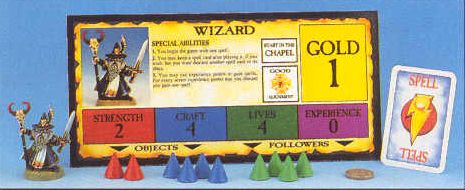
Cards: Talisman includes over 200 different cards. These are split into six different decks: Adventure cards, Spell cards. Purchase cards, Tower cards, Talisman cards and Toad cards. At the start of the game the cards should be carefully sorted into their different decks, and each deck given a good shuffle.
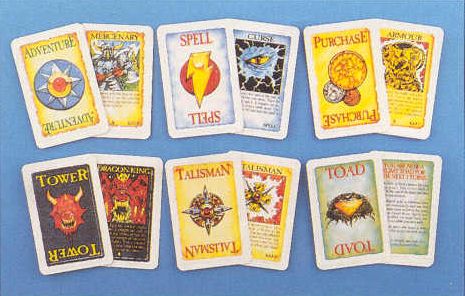
Counters: The cone-shaped counters are used to keep track of the characters' Strength (red), Craft (blue), Lives (green) and Experience Points (purple). They are placed in the appropriately coloured box on the player's character sheet. Each small counter is worth one point, and each large counter is worth 5 points. Different sized counters of the same colour can be swapped at any time (ie, you could swap 5 small green counters for one large green counter, or vice versa, but you may not swap green counters for red ones, etc).

Gold Coins: The Gold Coins are used to record the amount of gold pieces each character has. The value of each coin is shown on it. Coins of different values may be swapped at any time in order to make change (eg, you could swap one coin with a value of 5 for five coins with a value of 1, etc).
Toad pieces & Alignment markers: The Toad counters are used to replace the playing pieces of characters who have been turned into Toads by a magical spell. The Alignment counters are used to show a character's new alignment if it changes during the game.
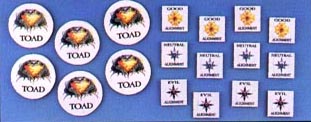
|
SETTING UP |
Shuffle the character cards and deal one to each player. Each player receives strength counters equal to the starting strength for their character. These should be placed on the appropriate space on their character card. The same is done for craft, lives and gold. Next each player takes the playing piece that corresponds to their character, and places it on the starting space listed on their character card.
Shuffle the adventure cards and place them face down beside the board, then do the same with the spell cards. The purchase cards and talisman cards, along with the remaining counters, are placed to one side for use during the game.
|
CHARACTER CARDS |
Your character card lists your character's starting strength, craft, lives and gold, as well as a number of special abilities that your character possesses. In any instance where a character's special abilities are at variance with the rules, the special ability takes precedence.
When you gain or lose counters or cards, they are added or removed from the character card as appropriate. With the exception of objects and spells, there is no limit to the number of counters or cards you may have.
Strength & Craft
Strength and craft represent how strong and intelligent your character is. Strength and craft can never drop below their starting levels. Bonuses to strength or craft gained from cards are not recorded with counters, but are added to your character's strength or craft when required.
Lives
Your character's lives show how physically fit the character is. If your character loses all its lives, it is dead and you will have to start with a new character in your next turn (see 'Death' below). During the game you will have the opportunity to regain lost lives. However, your character may never have its lives increased to higher than its starting value.
Alignment
Your character's alignment shows their personality. A good character is polite and law abiding, an evil character is a black-hearted villain, and neutral characters fall somewhere between these two extremes. If your character changes alignment, place an alignment counter on the character card to show the new alignment. If your character possesses any objects not permitted to the new alignment, those objects must immediately be placed face up in the space the character occupies.
Spells
In the magical land of Talisman anyone can use spells as long as they have enough craft. Some characters start the game with one or more spells, and new spells can be found by any character as they travel around the board. The maximum number of spells you may have at any one time is shown on the table below. You may not pick up a new spell if this would take the number of spells you have above this limit. If at any time you have more than this number of spells, then the surplus spells must immediately be discarded and cannot be cast. This is the only time that you are allowed to discard a spell card. The only other way to get rid of a spell is to cast it!
|
Total Craft |
1 |
2 |
3 |
4 |
5 |
6 or more |
|
Number of Spells |
0 |
0 |
1 |
2 |
2 |
3 |
Spells are kept face down so that the other players cannot see them. The effect of each spell, and when it can be cast, is detailed on the individual spell cards.
Gold, Objects & Followers
As you travel around the Talisman board you will get the chance to collect gold, objects and followers by taking adventure cards. Your character can only carry a total of four objects, and any excess must be left in the space that the character occupies. You may choose which objects your character decides to keep. There is no limit to the amount of gold or followers your character may have.
Unless a card states otherwise, you may ditch gold. objects or followers at any time. Any items ditched are placed, face up, in the space occupied by your character and can be picked up by the next player to end a move on that space. Note that a character is not allowed to ditch spells.

|
PLAYING THE GAME |
The owner of the game has the first turn. Play then proceeds round the board clockwise. When each player has had a turn, a complete round has been played. Each turn is split into two parts: first movement and then encounters.
Movement
The first thing you do in your turn is roll a dice to determine how many spaces your character must move. A character must always move, even if it starts the turn in a space with an adventure card or another character. The character may move either way round the board, but must be moved the full count of the dice roll. You are not allowed to back-track and enter a square for a second time when you move.
You may only cross between the outer and inner regions via the toll bridge, or if a card or space states that you may do so. For example, if you started at the chapel and rolled a 4, you could move four spaces to the hidden valley, crossing the toll bridge as you did so. However, every time you cross the toll bridge you must pay 1 gold. If you do not have the gold you may not cross!
You may only enter the Wizard's Tower from the causeway space. You must stop moving upon entering, even if you have some spaces of movement left over. If you start a turn in the tower, you must leave and travel round the inner region for a turn. You may not re-enter the tower on the same turn that you leave it.
Encounters
The second thing you do in each turn is resolve any encounters. You only have encounters in the space in which your character ends its move, or a space where it is moved as the result of an encounter. You must choose to either encounter the space itself or one other player who is in the space. If there are no other players on the space, you must encounter the space.
When you encounter a space, you follow the instructions on the space. If the space has one or more adventure cards already in it. follow the instructions for the space first, and then follow the instructions on the cards. Some instructions must be followed: others may be followed at your discretion.
If there is another character on a space where your character ends a move, you may choose to encounter them instead of the spare and any adventure cards in it. Encountering another player takes one of two forms. You may either attack them (see 'Attack's below) or use one of your character's special abilities on the other.
|
ADVENTURE CARDS |
Most of the spaces on the Talisman board instruct you to draw one or more adventure cards. Adventure cards are taken from the top of the adventure card deck and placed, face-up, in the space where they are encountered.
If there are any adventure cards already in a space, draw only enough new cards to take the total to the number indicated for the space. For example, if a space said 'Draw two adventure cards', but there was already one there, then you would only draw one new card to bring the total to two cards.
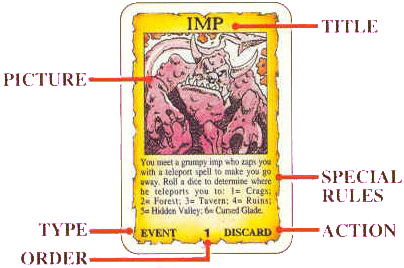
Adventure cards should be dealt with in the order determined by the number at the bottom centre of the card. The lowest number is tackled first, then the next lowest, and so on. In the case of a tie, you may choose what order to encounter the cards in.
The action in the bottom right corner of the card tells you what you must do:
Attack: The creature shown on the card attacks you (see 'Attacks' below). It remains in the space until it is killed.
Discard: Place the card on the discard pile after resolving its effects.
Keep: You may take and keep the card, subject to any restrictions printed on it (the Holy Lance may not be taken by evil characters, for example). Remember that you may not carry more than four objects at a time. If you do not take the card for any reason it remains in the space and will be encountered by the next player to land there.
Leave: Follow the instructions on the card and leave it in the space. It will be encountered again by the next player to land there.
|
ATTACKS |
Attacks are split into two types: battles and psychic combats. A battle occurs when you are attacked by a creature whose strength is given, and a psychic combat occurs when you are attacked by a creature whose craft is given. If you decide to attack another player. then you can choose to either fight a battle or a psychic combat.
Battles
To resole-e a battle against a monster, roll a dice and add your character's strength, plus any strength bonuses from followers or objects to the total. You may use any number of followers in the battle. You may also use any number of objects, though you may not use more than ONE of the following objects per battle: broadsword, battleaxe, doomsword, holy lance, bow.
Another player rolls a dice for the monster, and adds its strength to the score. If you have encountered more than one monster, they fight as one opponent adding their strengths together and adding one dice roll to the score.
It your score is higher, the monster is killed (discard the card). If the monster's score is higher, your character loses a life and your turn ends. If the scores are drawn, neither side is harmed and your turn ends. Note that if you lose or draw, your turn ends immediately. Any adventure cards you have not yet encountered will be left in the space (guarded by whatever it was that you were fighting) to be encountered by the next player to land on the space.
Battles between players are resolved in exactly the same way. However, the winner of the combat can choose to take one object or one bag of gold from the loser instead of making them lose a life.
If you or any other player want to cast spells that will affect a battle, the spell must be cast before the battle is resolved.
Psychic Combat
Psychic combat is resolved in exactly the same way as a battle, except that craft is substituted for strength.
Experience Points
Every time you defeat an opponent in battle or psychic combat, you receive a number of experience point counters equal to the opponent's strength or craft. Take the appropriate number of counters and place them on your character sheet. Experience points are not gained for defeating another player.
Experience points may be exchanged at any time for an extra strength, craft, gold or life counter. You gain one counter of your choice for every seven experience points discarded. You may choose which type of counter to take.
|
TOADS |
If you are turned into a toad you must take a toad card and place it on your character card. Follow the instructions on the toad card for as long as your character is a toad. When your character reverts to normal it regains its original strength and craft, but any lives it has lost are not regained.
|
DEATH |
If your character loses all of his lives, he is dead. Remove your playing piece from the board, put any objects, followers and gold to one side for the moment, and return any other cards and counters to the appropriate stock piles. In your next turn you start with a new character drawn at random from the unused character cards. The objects, followers and gold that were put to one side are 'inherited' by your new character and may be used by them as normal. Any objects or followers that may not be taken by the new character must be placed on the discard pile.
|
THE TALISMAN REALMS |
Talisman is the start of a lifetime of adventure. In preparation are three expansion sets which include new lands, monsters and fabulous treasures to discover. Watch out for these exciting products wherever Games Workshop games are sold.
|
THE MOST IMPORTANT RULE |
The sheer number of cards, spaces and characters in Talisman mean that every now and then a situation will arise that the rules do not specifically cover. Usually these situations are easily resolved, but if you do get completely stuck, simply write down the problem so that it can be answered with a yes or no and then roll a dice. On a 4-6 the answer is YES, on a 1-3 it is NO. If you want an official answer to a rules problem you can write to us at the address below. Include a stamped self-addressed envelope (or an international reply coupon if writing from abroad), and make sure any questions are worded so that they can be answered with a simple yes or no.
GAMES WORKSHOP TALISMAN QUESTIONS
16 CASTLE BOULEVARD,
NOTTINGHAM, NG7 1FL